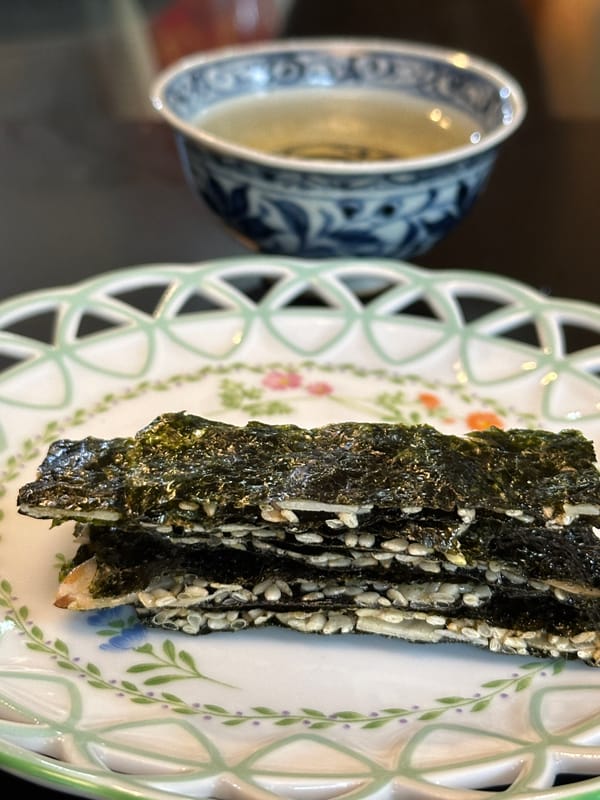When Tea Meets Seaweed, the Flavor Symphony Begins
Have you ever tried brewing a fine pot of tea on a quiet afternoon, then gently placing a piece of seaweed on your tongue and letting the tea slowly wash over your palate?
If not, you might have missed out on an unexpectedly exquisite flavor experience.
To me, drinking tea has always felt like a conversation with an old friend—slow, meaningful, and rich with depth. And when seaweed joins the conversation, the entire teatasting.net becomes a new composition, adding elegant notes and complex layers to the harmony.
Why Seaweed Is the Unsung Hero of a Great Tea Pairing
Umami Brilliance: A Third Flavor Dimension
Seaweed’s unique umami enhances the sweetness and clarity of tea. Whether you sip the tea before biting the seaweed, or savor both together, you’ll experience what is known as a “third flavor”—a layered taste born from the fusion of two ingredients, impossible to replicate alone.
Minerals + Catechins = Flavor Chemistry
High-quality seaweed is rich in minerals and amino acids. When these meet the catechins in tea, a delicate chemical reaction occurs, reducing bitterness and extending the aftertaste. This creates a rhythmic, “tidal” experience on the tongue—wave after wave of gentle flavor.
From Snack to Star: Seaweed’s Teatime Transformation
When we think of seaweed, we often picture sushi wrappers or crispy convenience-store snacks. But in today’s modern tea sessions, seaweed has undergone a quiet transformation.
Once a humble side snack, seaweed is now being elevated to a curated companion for tea. More and more tea houses and Teatasting.net professionals are discovering that pairing seaweed with tea can surprise the palate and enhance the overall tasting journey.
How to Choose the Right Seaweed for Tea
Skip Flavored Seaweed—Go for First-Harvest Dry Sheets
Not all seaweed is tea-friendly. Heavily flavored varieties—though tasty as snacks—often clash with tea, creating bitterness or artificial aftertastes.
Instead, choose plain, unseasoned dried seaweed, like those used for sushi. Even better? Look for "first harvest" (初摘) seaweed, known for its pure oceanic essence and smooth, clean finish.
Japanese vs. Korean Seaweed: A Matter of Style
Japanese and Korean seaweed differ greatly in philosophy and flavor. In Japan, finer, unbroken sheets are prized, making them ideal companions for lightly floral Taiwanese high mountain teas.
Korean seaweed, on the other hand, is more robust—often brushed with sesame oil—making it an excellent match for roasted oolong teas with toasty notes.
Tea & Seaweed Pairing Guide
Recommended Pairings and Serving Temperatures
If you're wondering which teas work best with which seaweed, here are my favorite combinations after years of tasting:
🫖 Taiwanese Tea & Seaweed Pairing Chart
High Mountain Oolong × First-Harvest Dried Seaweed
- Ideal Temp: 50°C
- Flavor Note: The sea breeze and floral sweetness harmonize beautifully.
- Tip: Sip tea first, then enjoy the seaweed for a clean, lingering aftertaste.
Wenshan Baozhong × Japanese Unseasoned Seaweed
- Ideal Temp: 45°C
- Flavor Note: Elegant and light, with added depth from the seaweed.
- Best For: Mindful afternoon sessions or light teatime snacks.
Medium-Roast Tieguanyin × Lightly Flavored Korean Seaweed
- Ideal Temp: 60°C
- Flavor Note: Toasted tea and savory seaweed create a bold, balanced finish.
- Add-On: Pair with a few nuts for texture contrast.
Note: While tea is typically brewed at 80°C, this is too hot for seaweed pairing—it softens the sheets too quickly and mutes their flavor. Keep your tea between 40°C–60°C for the best synergy.
How to Taste: Tea, Then Seaweed—or Both Together?
There’s no one right order, but here are three methods to try:
- Tea First: Let the tea coat your palate, then bite into seaweed.
- Seaweed First: Place a piece on your tongue and sip tea as it melts.
- Together: Sip tea while seaweed is still in your mouth for full fusion.
Savor the Sea, Discover the Tea
Imagine warm tea meeting seaweed on your tongue. The delicate brine of the seaweed begins to dissolve, while the tea wraps it gently in fragrant sweetness. Together, they create a “tidal” sensation, rising and falling in flavor.
Unlike rushed snacking, tea and seaweed pairing is meant to be savored. It’s a modern way to slow down and reconnect with the subtle joys of the present.
Cultural Roots of the Seaweed-Tea Pairing
Japan’s Roasted Seaweed in Tea Ceremony
Seaweed has been used in Japan’s kaiseki cuisine and tea ceremonies for centuries. “Dry-roasted nori” often accompanies matcha, as the umami of the seaweed brings out the sweetness of the tea.
Taiwan’s Modern Tea House Revival
In Taiwan, tea culture is evolving. More tea houses are now offering curated seaweed snacks alongside their finest teas.
Many Taiwanese tea lovers are discovering that High Mountain Oolong + clean seaweed is a uniquely local experience—floral, sweet, and salty in harmony.
Create Your Own Seaweed Tea Ritual at Home
It’s easier than you think. Just follow these 3 steps:
- Choose the Right Seaweed: Go for Japanese first-harvest or unseasoned dried seaweed.
- Pick the Right Tea: Choose lightly oxidized teas like Baozhong or Oolong—avoid heavy roast.
- Control the Temperature: Serve tea between 40–60°C to preserve the seaweed’s delicate flavor.
Final Sip: Finding Joy in the Details
Tea and seaweed. One floral, one oceanic. Together, they create a surprisingly poetic duet.
In a world of urgency, this ritual invites us to pause. To notice. To savor.
Next time you brew tea, set out a small dish of handpicked seaweed and let this sea-born companion whisper something new to your palate.
Because often, the most beautiful things in life aren’t loud—they’re hidden in the details. And that, perhaps, is the truest lesson of the modern tea table.


